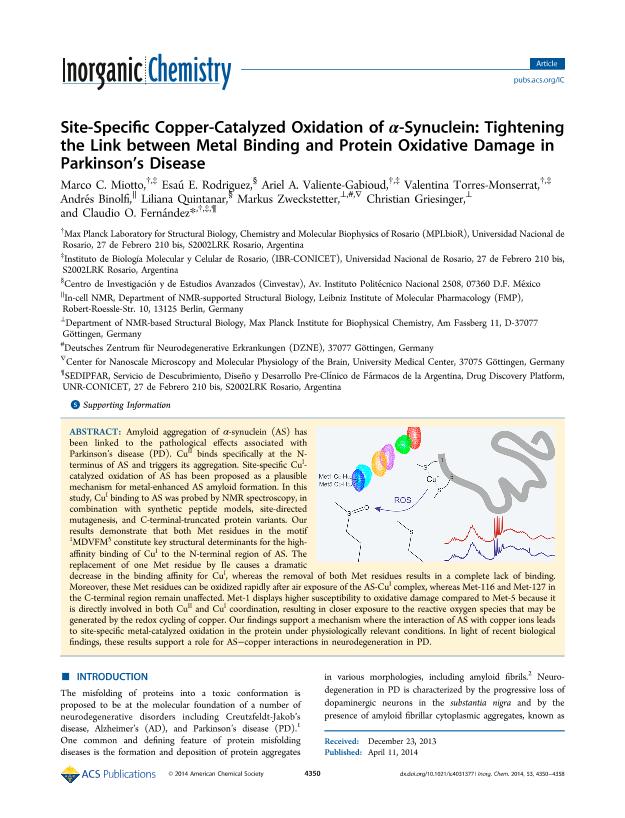Mostrar el registro sencillo del ítem
dc.contributor.author
Miotto, Marco César

dc.contributor.author
Rodriguez, Esaú E
dc.contributor.author
Valiente Gabioud, Ariel Alejandro

dc.contributor.author
Torres Monserrat, Valentina

dc.contributor.author
Binolfi, Andrés

dc.contributor.author
Quintanar, Liliana
dc.contributor.author
Zweckstetter, Markus
dc.contributor.author
Griesinger, Christian
dc.contributor.author
Fernandez, Claudio Oscar

dc.date.available
2017-12-20T13:44:39Z
dc.date.issued
2014-04
dc.identifier.citation
Fernandez, Claudio Oscar; Griesinger, Christian; Zweckstetter, Markus; Quintanar, Liliana; Binolfi, Andrés; Torres Monserrat, Valentina; et al.; Site-Specific Copper-Catalyzed Oxidation of α-Synuclein: Tightening the Link between Metal Binding and Protein Oxidative Damage in Parkinson’s Disease; American Chemical Society; Inorganic Chemistry; 53; 4-2014; 4350-4358
dc.identifier.issn
0020-1669
dc.identifier.uri
http://hdl.handle.net/11336/31089
dc.description.abstract
The amyloid aggregation of alpha-synuclein (AS) has been linked to the pathological effects associated to Parkinson´s disease (PD). Cu(II) binds specifically at the N-terminus of AS and triggers its aggregation. Site-specific Cu(I)-catalyzed oxidation of AS has been proposed as a plausible mechanism for metal-enhanced AS amyloid formation. In this study, Cu(I) binding to AS was probed by NMR spectroscopy, in combination with synthetic peptide models, site- directed and C-terminal truncated protein variants. Our results demonstrate that both Met residues in the motif 1MDVFM5 constitute key structural determinants for the high-affinity binding of Cu(I) to the N-terminal region of AS. Replacement of one Met residue by Ile causes a dramatic decrease in binding affinity for Cu(I), whereas removal of both Met residues results in complete lack of binding. Moreover, these Met residues can be oxidized rapidly after air exposure of the AS-Cu(I) complex, whereas Met-116 and Met-127 in the C-terminal region remain unaffected. Met-1 displays higher susceptibility to oxidative damage compared to Met-5, as it is directly involved in both Cu(II) and Cu(I) coordination, resulting in a closer exposure to the reactive oxygen species that may be generated by the redox cycling of copper. Our findings support a mechanism where the interaction of AS with copper ions leads to site-specific metal catalyzed oxidation in the protein under physiologically relevant conditions. In light of recent biological findings, these results support a role for AS-copper interactions in neurodegeneration in PD.
dc.format
application/pdf
dc.language.iso
eng
dc.publisher
American Chemical Society

dc.rights
info:eu-repo/semantics/openAccess
dc.rights.uri
https://creativecommons.org/licenses/by-nc-sa/2.5/ar/
dc.subject
Alfa-Sinucleina
dc.subject
Cobre
dc.subject
Oxidación
dc.subject.classification
Otras Ciencias Químicas

dc.subject.classification
Ciencias Químicas

dc.subject.classification
CIENCIAS NATURALES Y EXACTAS

dc.subject.classification
Otras Ciencias Biológicas

dc.subject.classification
Ciencias Biológicas

dc.subject.classification
CIENCIAS NATURALES Y EXACTAS

dc.title
Site-Specific Copper-Catalyzed Oxidation of α-Synuclein: Tightening the Link between Metal Binding and Protein Oxidative Damage in Parkinson’s Disease
dc.type
info:eu-repo/semantics/article
dc.type
info:ar-repo/semantics/artículo
dc.type
info:eu-repo/semantics/publishedVersion
dc.date.updated
2017-12-04T19:16:08Z
dc.journal.volume
53
dc.journal.pagination
4350-4358
dc.journal.pais
Estados Unidos

dc.journal.ciudad
Washington
dc.description.fil
Fil: Miotto, Marco César. Universidad Nacional de Rosario; Argentina. Consejo Nacional de Investigaciones Científicas y Técnicas. Centro Científico Tecnológico Conicet - Rosario. Instituto de Biología Molecular y Celular de Rosario. Universidad Nacional de Rosario. Facultad de Ciencias Bioquímicas y Farmacéuticas. Instituto de Biología Molecular y Celular de Rosario; Argentina
dc.description.fil
Fil: Rodriguez, Esaú E. Centro de Investigación y de Estudios Avanzado. DF; México
dc.description.fil
Fil: Valiente Gabioud, Ariel Alejandro. Consejo Nacional de Investigaciones Científicas y Técnicas. Centro Científico Tecnológico Conicet - Rosario. Instituto de Biología Molecular y Celular de Rosario. Universidad Nacional de Rosario. Facultad de Ciencias Bioquímicas y Farmacéuticas. Instituto de Biología Molecular y Celular de Rosario; Argentina. Universidad Nacional de Rosario; Argentina
dc.description.fil
Fil: Torres Monserrat, Valentina. Universidad Nacional de Rosario; Argentina. Consejo Nacional de Investigaciones Científicas y Técnicas. Centro Científico Tecnológico Conicet - Rosario. Instituto de Biología Molecular y Celular de Rosario. Universidad Nacional de Rosario. Facultad de Ciencias Bioquímicas y Farmacéuticas. Instituto de Biología Molecular y Celular de Rosario; Argentina
dc.description.fil
Fil: Binolfi, Andrés. Leibniz Institute of Molecular Pharmacology. Berlin; Alemania
dc.description.fil
Fil: Quintanar, Liliana. Centro de Investigación y de Estudios Avanzado. DF; México
dc.description.fil
Fil: Zweckstetter, Markus. Max Planck Institute for Biophysical Chemistry, Gottingen; Alemania. Deutsches Zentrum für Neurodegenerative Erkrankung. Gottingen; Alemania. University Medical Center. Gottingen; Alemania
dc.description.fil
Fil: Griesinger, Christian. Max Planck Institute for Biophysical Chemistry, Gottingen; Alemania
dc.description.fil
Fil: Fernandez, Claudio Oscar. Consejo Nacional de Investigaciones Científicas y Técnicas. Centro Científico Tecnológico Conicet - Rosario. Instituto de Biología Molecular y Celular de Rosario. Universidad Nacional de Rosario. Facultad de Ciencias Bioquímicas y Farmacéuticas. Instituto de Biología Molecular y Celular de Rosario; Argentina. Universidad Nacional de Rosario; Argentina
dc.journal.title
Inorganic Chemistry

dc.relation.alternativeid
info:eu-repo/semantics/altIdentifier/url/http://pubs.acs.org/doi/10.1021/ic4031377
dc.relation.alternativeid
info:eu-repo/semantics/altIdentifier/doi/http://dx.doi.org/10.1021/ic4031377
Archivos asociados
